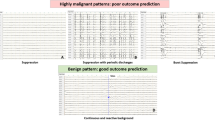Abstract
Multimodally evoked potentials were registered in 85 patients who fulfilled the criteria for brain death. While samatosensory and visual evoked potentials have been found to be of limited value for the diagnosis of brain death, the stepwise abolition of brain stem auditory evoked potentials (BAEP) confirmed brain death in 26 out of 85 patients, i. e. 31%.
Registration of the abolition of BAEP is concluded to be a safe and acceptable confirmatory test. It is, however, more feasible for institutions, in which BAEP are analysed routinely. In spite of all efforts sequential BAEP could not be used for the diagnosis of brain death in the majority of cases either because of absence of reproducible responses at the initial registration or because the patient was already apnoic at the time of the initial BAEP. Assuming that bilateral preservation of wave I has the same significance as the stepwise abolition of BAEP, since it also proves the integrity of the peripheral receptor, BAEP are relevant for the declaration of brain death in approximately 30% of patients.
Similar content being viewed by others
References
Anziska BJ, RQ Cracco: Short latency somatosensory evoked potentials in brain dead patients. Arch Neurol 37 (1980) 222–225
Arfel G: Stimulations visuelles et silence cérébral. Electroenceph clin Neurophysiol 23 (1967) 172–175
Belsh JM, S Chokroverty: Short latency somatosensory evoked potentials in brain-dead patients. Electroenceph clin Neurophysiol 68 (1987) 75–78
Biniek R, A Ferbert, H Buchner, H Brückmann: Loss of brainstem acoustic evoked potentials with spontaneous breathing in a patient with supratentorial lesion. Eur Neurol 30 (1990) 38–41
Brunko E, D Zegers de Beyl: Prognostic value of early cortical somatosensory evoked potentials after resuscitation from cardiac arrest. Electroenceph clin Neurophysiol 66 (1987) 15–24
Desbordes JM, C Krémer, M Mesz, B Deglaire, F Maissin, B Bataille, A Marillaud: Potentials évoqués auditifs du tronc cérébral dans la mort cérébrale. Ann Fr Anesth Réanim 7 (1988) 13–16
Ferbert A, H Buchner, E Ringelstein, W Hacke: Isolated brain-stem death. Case report with demonstration of preserved visual evoked potentials (VEPs). Electroenceph clin Neurophysiol 65 (1986) 157–160
Firsching R: The brain-stem and 40 Hz middle latency auditory evoked potentials in brain death. Acta Neurochir 101 (1989) 52–55
Firsching R: Evoked potentials in head injury. In: Advances in Neurotraumatology. RP Vigouroux, RA Frowein (eds) Springer, Wien New York 1991
Firsching R, RA Frowein: Multimodality evoked potentials and early prognosis in comatose patients. Neurosurg Rev 13 (1990) 141–146
Frowein RA, H Gänshirt, KE Richard, E Hamel, WF Haupt: Kriterien des Hirntodes: 3. Generation. Anästh Intensivther Notfallmed 22 (1987) 17–20
Ganes T, P Nakstad: Subcomponents of the cervical evoked response in patients with intracerebral circulatory arrest. J Neurol Neurosurg Psych 47 (1984) 292–297
Goldie WD, KH Chiappa, RR Young, E Brooks: Brainstem auditory and short-latency somatosensory evoked responses in brain death. Neurol 31 (1981) 248–256
Guerit JM, P Mahieu: Are evoked potentials a valuable tool for the diagnosis of brain death? Transplantation Proceedings Vol XVIII 3, Grune & Stratton Inc (1986) 386–387
Hall JW, J Mackey-Hargadine, E Kim: Auditory brain-stem response in determination of brain death. Arch Otolaryngol 111 (1985) 613–620
Pfurtscheller G, G Schwaz, W List: Brain death and bioelectrical brain activity. Intens Care Med 11 (1985) 149–153
Rossini P, R Kula, W House, R Cracco: Alteration of brainstem auditory evoked responses following cardiorespiratory arrest and resuscitation. Electroenceph clin Neurophysiol 54 (1982) 232–234
Shiogai T: Evaluation of electrophysiological neuromonitoring in the diagnosis of brain death. No-To-Shinkei 41 (1989) 73–83
Starr A: Auditory brain-stem responses in brain death. Brain 90 (1976) 543–554
Stöhr M, B Riffel, E Trost, P Wengert: Bedeutung der somatosensibel evozierten Potentiale (SEP) bei der Feststellung des Hirntodes. Anaesth Intensivther Notfallmed 22 (1987) 21–25
Stöhr M, E Trost, A Ullrich, B Riffel, P Wengert: Bedeutung der frühen akustisch evozierten Potentiale bei der Feststellung des Hirntodes. Dtsch med Wschr 111 (1986) 1515–1519
Trojaborg W, E Jørgensen: Evoked cortical potentials in patients with ‘isoelectric’ EEG. Electroenceph clin Neurophysiol 35 (1973) 301–309
Wilkud R, G Chatrian, E Lettich: The electroretinogram during terminal anoxia in humans. Electroenceph clin Neurophysiol 31 (1971) 537–546
Wissenschaftlicher Beirat der Bundesärztekammer: Kriterien des Hirntodes. Entscheidungshilfen zur Feststellung des Hirntodes. Dtsch Ärztebl 83 (1986) 2940–2946
Yokoyama T, K Uemura, H Ryu, T Miyamoto, K Sugiyama, T Tokuyama, A Shirasaka: The findings of auditory and somatosensory evoked potentials in brain death confirmed by the apnea test. To-To-Shinkei 40 (1988) 561–567
Zegers de Beyl D, E Brunko: Prediction of chronic vegetative state with somatosensory evoked potentials. Neurol 36 (1986) 134
Author information
Authors and Affiliations
Rights and permissions
About this article
Cite this article
Firsching, R., Frowein, R.A., Wilhelms, S. et al. Brain death: practicability of evoked potentials. Neurosurg. Rev. 15, 249–254 (1992). https://doi.org/10.1007/BF00257800
Received:
Accepted:
Issue Date:
DOI: https://doi.org/10.1007/BF00257800




